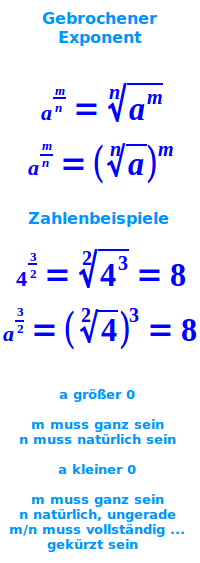 Man sieht zwei gleichwertige Regeln für gebrochene Exponenten.
© Gunter Heim => Zurück zum Artikel
Man sieht zwei gleichwertige Regeln für gebrochene Exponenten.
© Gunter Heim => Zurück zum Artikel
Gebrochener Exponent
Bildinfo und Lizenz
Bildinfo
- Man sieht zwei gleichwertige Regeln für gebrochene Exponenten.
- 1) a^(m/n) = n-te Wurzel aus a^m
- 2) a^(m/n) = (n-te Wurzel aus a)^m
- Darunter sieht man je ein Zahlenbeispiel:
- 1) 4^(3/2) = 2-te Wurzel aus 4³ = 2-te Wurzel aus 64 = 8
- 2) 4^(3/2) = (2-te Wurzel aus 4)³ = 2³ = 8
- Darunter stehen die Definitionsbereiche für a, b und m.
- Falls a > 0 ist: m ganzzahlig, n beliebig natürlichzahlig.
- Falls a < 0 ist: m ganzzahlig, n natürlich und ungerade
- Falls a < 0 ist: m/n muss vollständig gekürzt sein.
Source
- Created: February 27th, 2019
License
- This image is in the Public Domain.
- You may use it, redistribute and modify it in any way.
- You do not need to attribute the author of this image.
Warranty
- No guarantee can be given as to the correctness of facts implied or explicitly stated.
- Usage is completey at your own risk. 💣
Originalseite
- Das Bild ist Teil eines online-Lexikons.
- Rhetos Lernlexikon Mathematik, Aachen:
 Man sieht zwei gleichwertige Regeln für gebrochene Exponenten.
© Gunter Heim => Zurück zum Artikel
Man sieht zwei gleichwertige Regeln für gebrochene Exponenten.
© Gunter Heim => Zurück zum Artikel